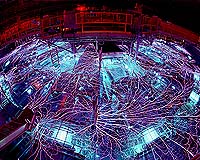 |
Berlin, Germany (SPX) Apr 18, 2011 A newly discovered magnetic phenomenon could accelerate data storage by several orders of magnitude. With a constantly growing flood of information, we are being inundated with increasing quantities of data, which we in turn want to process faster than ever. Oddly, the physical limit to the recording speed of magnetic storage media has remained largely unresearched. In experiments performed on the particle accelerator BESSY II of Helmholtz-Zentrum Berlin, Dutch researchers have now achieved ultrafast magnetic reversal and discovered a surprising phenomenon. In magnetic memory, data is encoded by reversing the magnetization of tiny points. Such memory works using the so-called magnetic moments of atoms, which can be in either "parallel" or "antiparallel" alignment in the storage medium to represent to "0" and "1". The alignment is determined by a quantum mechanical effect called "exchange interaction". This is the strongest and therefore the fastest "force" in magnetism. It takes less than a hundred femtoseconds to restore magnetic order if it has been disturbed. One femtosecond is a millionth of a billionth of a second. Ilie Radu and his colleagues have now studied the hitherto unknown behaviour of magnetic alignment before the exchange interaction kicks in. Together with researchers from Berlin and York, they have published their results in Nature (DOI: 10.1038/nature09901, 2011). For their experiment, the researchers needed an ultra-short laser pulse to heat the material and thus induce magnetic reversal. They also needed an equally short X-ray pulse to observe how the magnetization changed. This unique combination of a femtosecond laser and circular polarized, femtosecond X-ray light is available in one place in the world: at the synchrotron radiation source BESSY II in Berlin, Germany. In their experiment, the scientists studied an alloy of gadolinium, iron and cobalt (GdFeCo), in which the magnetic moments naturally align antiparallel. They fired a laser pulse lasting 60 femtoseconds at the GdFeCo and observed the reversal using the circular-polarized X-ray light, which also allowed them to distinguish the individual elements. What they observed came as a complete surprise: The Fe atoms already reversed their magnetization after 300 femtoseconds while the Gd atoms required five times as long to do so. That means the atoms were all briefly in parallel alignment, making the material strongly magnetized. "This is as strange as finding the north pole of a magnet reversing slower than the south pole," says Ilie Radu. With their observation, the researchers have not only proven that magnetic reversal can take place in femtosecond timeframes, they have also derived a concrete technical application from it: "Translated to magnetic data storage, this would signify a read/write rate in the terahertz range. That would be around 1000 times faster than present-day commercial computers," says Radu.
Share This Article With Planet Earth
Related Links Helmholtz-Berlin Space Technology News - Applications and Research
 Researchers Discover The Cause Of Irradiation-Induced Instability In Materials Surfaces
Researchers Discover The Cause Of Irradiation-Induced Instability In Materials SurfacesBoston MA (SPX) Apr 18, 2011 A new discovery about the dynamic impact of individual energetic particles into a solid surface improves our ability to predict surface stability or instability of materials under irradiation over time. The finding may lead to the design of improved structural materials for nuclear fission and fusion power plants, which must withstand constant irradiation over decades. It may also accelera ... read more |
|
| The content herein, unless otherwise known to be public domain, are Copyright 1995-2010 - SpaceDaily. AFP and UPI Wire Stories are copyright Agence France-Presse and United Press International. ESA Portal Reports are copyright European Space Agency. All NASA sourced material is public domain. Additional copyrights may apply in whole or part to other bona fide parties. Advertising does not imply endorsement,agreement or approval of any opinions, statements or information provided by SpaceDaily on any Web page published or hosted by SpaceDaily. Privacy Statement |